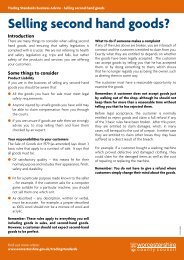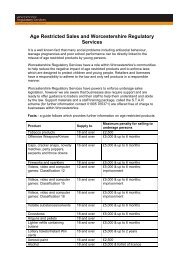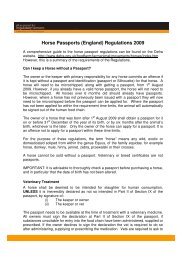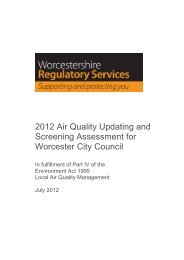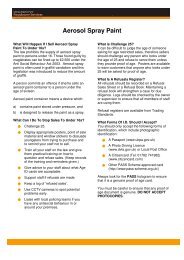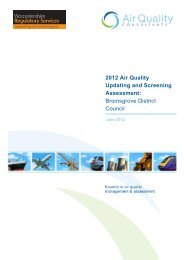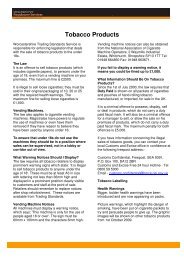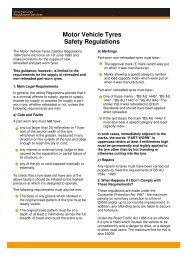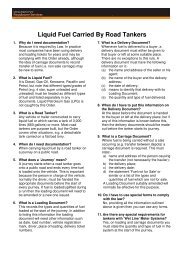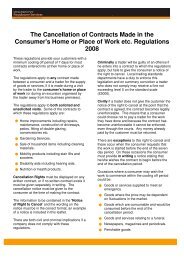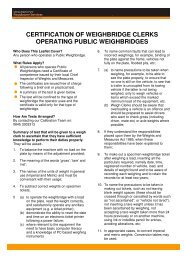The Average and Minimum Quantity Systems - Worcestershire ...
The Average and Minimum Quantity Systems - Worcestershire ...
The Average and Minimum Quantity Systems - Worcestershire ...
Create successful ePaper yourself
Turn your PDF publications into a flip-book with our unique Google optimized e-Paper software.
<strong>The</strong> <strong>Average</strong> <strong>and</strong> <strong>Minimum</strong> <strong>Quantity</strong> <strong>Systems</strong>1 <strong>The</strong> <strong>Minimum</strong> SystemThis is the traditional system of weights <strong>and</strong>measures that has operated for manyyears, <strong>and</strong> applies to both pre-packed <strong>and</strong>non-pre-packed goods. It requires thatgoods that are sold or offered for supply byquantity must be at least the weight,measure or number as stated by the seller.Any weighing or measuring equipment usedin connection with the minimum systemMUST be prescribed <strong>and</strong> stamped,although there is no compulsion to use anyequipment - the amount of goods beingoffered by the seller may be estimated, <strong>and</strong>,provided he estimates correctly, he commitsno offence. However, if he estimatesincorrectly, he has no defence against acharge of short weight or measure.2 <strong>The</strong> <strong>Average</strong> System<strong>The</strong> average quantity system of weights <strong>and</strong>measures, which only applies to packagedgoods, has now been in operation since1980 <strong>and</strong> is used throughout the UnitedKingdom <strong>and</strong> Europe. New Regulationswere introduced in 2006 to simplify theprevious legislation.This system takes the emphasis formetrological control from the point of retailsale back to the place of packing, therationale being that it is better not toproduce defective packages - that is, shortweight or measure - than to deal with suchitems when they are already in the retailchain. At the same time, it recognizes thatno packing machinery is perfect, so certaindeficiencies are tolerated. Provided theaverage quantity of a group of items isequal to or more than the declared quantity<strong>and</strong> the degree of deficiency of theindividual items is not too great, then thegoods are considered to satisfy thelegislation.<strong>The</strong> system applies to all goods which arenormally sold in packages by weight ormeasure (but not count), <strong>and</strong> where thegoods are:-made up in predetermined constantquantities of 5 grams to 25 kilograms or 5millilitres to 25 litres,made up otherwise than in the presence ofthe purchaser, <strong>and</strong>made up in packages where none of thegoods can be removed without opening thepackage.All foods <strong>and</strong> non-foods that satisfy these threerequirements are now covered by the PackagedGoods Regulations 2006.Goods packed to this system may be markedwith the “e” mark although there is norequirement that they must be unless they arepacked to be distributed elsewhere in the EU.<strong>The</strong> "e"-mark is a guarantee, recognizedthroughout the European Union, that thepackages to which it has been applied havebeen packed in accordance with the relevant EUDirective <strong>and</strong> have been monitored at the placeof packaging or importation by the appropriatemetrological authority. It therefore actsthroughout the Community as a "metrologicalpassport" when applied to appropriatepackages.Loose bread, yarn <strong>and</strong> whole poultry have allbeen brought into the system in this country,<strong>and</strong> the legislation has been modified inappropriate ways to accommodate these"oddities".Under the average weight system the packer orimporter is responsible for ensuring that thegoods they pack are to the three packers' rules.<strong>The</strong> actual contents of all the packagesproduced shall not be less, on average,than the nominal (marked) quantity.<strong>The</strong> proportion of packages which are shortof the stated quantity by a defined amount(the TNE) shall be less than the specifiedamount.No package should be short by more thantwice the TNE.TS0901
TNE means Tolerable Negative Error, which isan amount prescribed by Regulation, <strong>and</strong> isrelated to the nominal quantity of the package.(See Annex A for details).<strong>The</strong> packer may satisfy these rules by either oneof two means.He may EITHER:Carry out checks that are sufficientlyrigorous to ensure that the packages arepacked to the above rules using suitableequipment <strong>and</strong> to make <strong>and</strong> keep records ofthose checks together with records ofcorrections <strong>and</strong> adjustments that the checkshave shown to be necessary.ORUse suitable equipment to make up each<strong>and</strong> every package - this implies weighingor measuring every package individually<strong>and</strong> is equivalent to the traditional minimumsystem. This approach will probably only besuitable for small volume packers.If the packer opts for this approach there isno requirement in the regulations that heshould keep records<strong>The</strong> Regulations specify that records must bekept until the use by or best before date on thegoods or for a period of one year after the dateof packing, whichever is the shorter. However, itmust be noted that an action for short weight ormeasure may be taken up to one year after thedate of packing so it is advisable for the packerto retain any records for that period to enablehim to prove his defence.<strong>The</strong> Regulations now specify that equipmentused to make checks should be ‘suitable’ for theuse to which it is put. Guidance from BIS hasspecified that equipment that is used for the firsttime on or after 6 April 2006 for either making upor checking packages must be verified beforeuse, i.e. be ‘stamped’ or ‘stickered’. Equipmentsuch as check-weighers <strong>and</strong> templates maycontinue to be used but the packer must be ableto demonstrate their accuracy.<strong>The</strong> packer or importer must also mark thepackages with a quantity declaration <strong>and</strong> hisname <strong>and</strong> address (or a mark which enables hisname <strong>and</strong> address to be readily ascertained).<strong>The</strong> Regulations specify that packagescontaining liquids must be marked with volume<strong>and</strong> packages containing other products shall bemarked with weight <strong>and</strong> lay down minimumheights for words <strong>and</strong> figures used in thequantity declaration:Not exceeding 50g/50ml50g/ml to 200g/ml200g/ml to 1kg/lExceeding 1kg/l2mm3mm4mm6mm<strong>The</strong> quantity declaration must be indelible,easily legible <strong>and</strong> visible in normal conditions ofpresentation. This has been interpreted to meanthat the quantity declaration must be on the faceof the packaging that is normally presented tothe consumer rather than the back or side of thepack.An Inspector of Weights <strong>and</strong> Measures willassess whether the packer has complied withthe three packers' rules by carrying out areference test. <strong>The</strong> reference test is a formalizedtest carried out on a sample of packagesselected at r<strong>and</strong>om from a batch of packages.When sampled at the end of a packing line abatch is a quantity equal to one hour'sproduction, in all other cases the batch size shallbe limited to 10,000, where the batch is madeup of less than 100 packages (e.g. at a smallbaker's premises) the batch will comprise all ofthe packages produced.No person other than the packer or importer canbe liable for the sale or possession for sale forshort weight packages, unless he knows or hasreasonable grounds for believing that thepackage is inadequate, or that he knows comesfrom a batch of product that has failed areference test.<strong>The</strong> Regulations are supported by a number ofcodes of practice including the Code of PracticalGuidance for Packers <strong>and</strong> more specific codesfor certain sectors including Plant Bakers, SmallBakers, Beer <strong>and</strong> Cider Packers, Soft DrinkPackers, Dairies, Poultry Packers <strong>and</strong> BiscuitMakers. None of these codes have legal forcebut simply offer guidance on compliance.
Annex AExtract from:-<strong>The</strong> Weights <strong>and</strong> Measures (Packaged Goods) Regulations 2006 SI 659<strong>The</strong> tolerable negative error shall be the amount set out in the Table below in relation to the nominalquantity on the package.TableTolerable negative errorNominal quantity in grams or millilitres As a percentage of nominal g or mlquantity5 - 50 9 -50 - 100 - 4.5100 - 200 4.5 -200 - 300 - 9300 - 500 3 -500 - 1000 - 151000 - 10000 1.5 -10000 - 15000 - 150above 15000 1 -(2) In calculating, in units of weight or volume, the amount of a tolerable negative error in the casesshown in the above Table where the error is to be taken as a percentage of nominal quantity, theamount shall be rounded up to the nearest one-tenth of a gram or millilitre as the case may be.How to contact <strong>Worcestershire</strong> Regulatory ServicesConsumer Advice - regarding issues relating to ‘Consumer goods or Services’ contact Citizens AdviceConsumer Service on 08454 040506, alternatively research your consumer rights on the HMGovernment, DirectGov website www.direct.gov.ukBusiness Advice only - telephone 0845 330 3313, or email wrsenquiries@worcsregservices.gov.ukGeneral Customer Enquiries - contact the <strong>Worcestershire</strong> Hub on 01905 822799 (Mon – Fri 8am-8pm,Sat 9am-5pm) or visit your local Customer Service Centre. Opening times <strong>and</strong> locations can be found atwww.whub.org.ukPostal address – <strong>Worcestershire</strong> Regulatory Services, PO Box 866, Worcester, WR1 9DPFind us on Facebook: facebook.com/worcsregservicesFollow us on Twitter: @worcsrsTS0901




